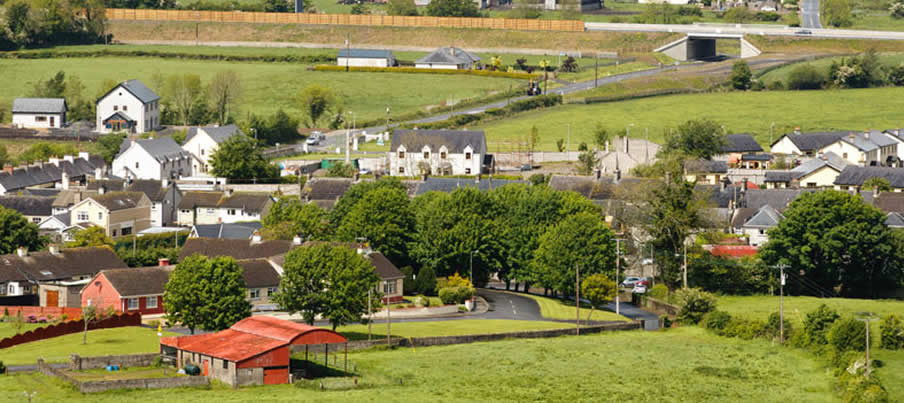Moneygall History and Heritage

Moneygall .... Our Heritage
The village of Moneygall lies in the Parish of Dunkerrin. The parish comprises of 67 townlands three of which are detached from the main portion by the intervention of parts of the Parishes of Roscrea and Shinrone. It is part of counties Offaly and Tipperary and covers approximately 24,500 acres. The population of the parish is approx. 1600 people. The land for the most part is a plain, rising in a gentle slope from North to South and culminating in the hill of Crimlin and Rathnavogue with Benduff as their highest point reaching to1399 feet. These hills serve as a watershed dividing the upper reaches of the Nore and Suir rivers which flow south east, from the sources of the little Brosna and the Ballyfinboy which follow a North-Westerly course to Lough Derg and the Shannon. The underlying rock in the plain is carboniferous limestone and the numerous round backed hills or Drumlins yield rich deposits of sand and gravel used in building and road making. Approaching the hills the limestone merges into old red sandstone which contains light veins of copper and iron. The land is mainly fertile and the farming is a mixture of Dairying and the raising of dry stock and sheep, with a decreasing areage of tillage. Many boglands, which gave good fuel for centuries, have been exhausted and reclaimed as farmland or planted forests. In the bogs that remain turf is cut by modern machinery methods. Moneygall, Dunkerrin and Barna have many wonderful heritage sites which are waiting to be explored. These sites have significance to our area but also have a place in our hearts.
Moneygall……The Name

The name Moneygall (Muine Gall in Irish) means “The Shrubbery of the foreigners”.
History tells us that as the Norsemen were retreating from the battle of Roscrea in 942, they were overtaken and killed in this area. It is believed that human remains unearthed near Monegall in the 19TH century are the remains of some of these Norsemen.
Population, Facts and Emigration
In 1841 the population of the entire parish was approximately 8,500. Thirty years later in 1871 the population had dropped to about 4,000. A lesser decline continued for the remainder of the 19th century at the end of which the population was 2,500. Today the population is about 1,600. The decline in the population in the second half of the 19th century can be attributed to the famine and the terrible destruction it caused. Huge numbers died and many more were forced to emigrate. Emigration was a final parting with friends, relations and native place, although there was always the hope, rarely realised, of returning home someday. Mrs. Stephenson, an emigrant in America expressed that hope in the following lines:
An Exiles Wish
I wish that I could see again a village I love well,
The Longing that is in my heart I could never never tell,
To see that dear old place once more it is my hope my all,
The sweetest vale in Ireland fair is beauteous Moneygall.
I wish that I could see again the New Line and Lodge Road,
Where I did dearly love to roam in the dear clear days of old,
And not forgetting Thumpane’s Lane, I loved it best of all,
With its primrose dell and sweet bluebell in beauteous Moneygall.
I wish that I could wonder o’er the green and grassy mead,
And down through Derrycallaghan where the lovely lambkins feed.
Or climb up Crimblin Mountain where the echoes loud did call,
From that mountain rare to the valley fair in beauteous Moneygall.
I wish that I could see again my darling mothers face,
It would erase the cares and trials I’ve borne for years and years,
To see her just one little while all troubles would seem small,
Could I clasp her in my arms again in beauteous Moneygall.
Its years and years since I have left old Ireland far away,
But still it dosent seem so long as tho ‘ ‘twere yesterday,
Should e’er I stand upon her strand fond places I’d recall,
And I’ll ne’er forget the Bluestone Blue and the Bridge of Moneygall.
Mrs. Stephenson
Moneygall History
Moneygall history spans back as far as 942AD... read more about the History of Moneygall

 MENU
MENU